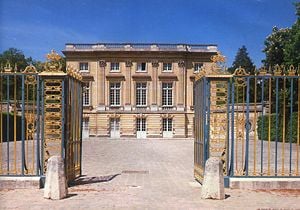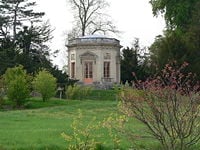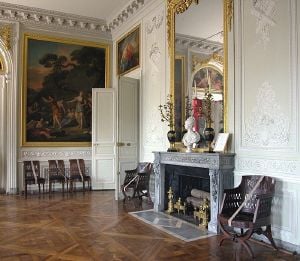Difference between revisions of "Petit Trianon" - New World Encyclopedia
David Doose (talk | contribs) m |
|||
| Line 1: | Line 1: | ||
{{coor title d|48.815639|N|2.109675|E|type:landmark_region:FR}} | {{coor title d|48.815639|N|2.109675|E|type:landmark_region:FR}} | ||
{{for|the building of the same name in California|Le Petit Trianon}} | {{for|the building of the same name in California|Le Petit Trianon}} | ||
| − | [[Image:Versailles Petit Trianon.jpg|thumb| | + | [[Image:Versailles Petit Trianon.jpg|thumb|300px|The Petit Trianon]] |
The '''Petit Trianon''' is a small [[château]] located on the grounds of the [[Palace of Versailles]] in [[Versailles]], [[France]]. It was designed by [[Ange-Jacques Gabriel]] by order of [[Louis XV of France|Louis XV]] for his long time mistress, [[Madame de Pompadour]], and was constructed between 1762-1768. | The '''Petit Trianon''' is a small [[château]] located on the grounds of the [[Palace of Versailles]] in [[Versailles]], [[France]]. It was designed by [[Ange-Jacques Gabriel]] by order of [[Louis XV of France|Louis XV]] for his long time mistress, [[Madame de Pompadour]], and was constructed between 1762-1768. | ||
Revision as of 03:41, 9 August 2008
The Petit Trianon is a small château located on the grounds of the Palace of Versailles in Versailles, France. It was designed by Ange-Jacques Gabriel by order of Louis XV for his long time mistress, Madame de Pompadour, and was constructed between 1762-1768.
Marie Antoinette, Queen Cosort of Louis XVI, would come to the Petit Trianon not only to escape the formality of court life, but also to shake off the burden of her royal responsibilities. All protocol regarding admittance to the property was "de par la Reine" (by order of the Queen) It was said that not even her husband, the King, could enter without her express permssion. Such exclusivity alienated the court nobility since only the queen's "inner circle" (including the Princess de Lamballe, and Gabrielle de Polastron, duchesse de Polignac) were invited. Cause of controversy, legacy of beauty
Background
Madame de Pompadour died 4 years before its completion, and it was subsequently occupied by her successor, Madame du Barry. Upon his accession to the throne in 1774, the 20-year-old Louis XVI gave the château and its surrounding park to his 19-year-old Queen Marie Antoinette for her exclusive use and enjoyment.
Architecturural Style
The château of the Petit Trianon is a celebrated example of the transition from the Rococo style of the earlier part of the 18th century, to the more sober and refined, Neoclassical style of the 1760's and onward. The exterior of the château is simple and elegant, architecturally correct, and highly original. Essentially an exercise on a cube, the Petit Trianon attracts interest by virtue of its four facades, each thoughtfully designed according to that part of the estate it would face. The Corinthian order predominates, with two detached and two semi-detached pillars on the side of the formal French garden, and pilasters facing both the courtyard and the area once occupied by Louis XV's greenhouses. Overlooking the former botanical garden of the king, the remaining facade was left bare. The subtle use of steps compensates for the differences in level of the château's inclined location.
A house of intimacy and of pleasure, the building was designed to require as little interaction between guests and servants as possible. To that end, the table in the salles à manger was conceived to be mobile, mechanically lowered and raised through the floorboards so that the servants below could set places sight unseen. The tables were never built, but the delineation for the mechanical apparatus can still be seen from the foundation.
Within the queen's apartment, one discerns Marie Antoinette's incessant need for privacy: the decor of her boudoir displays an inventiveness unique to the age, featuring mirrored panels that, by the simple turning of a crank, can be raised or lowered to obscure the windows. Her bedroom, although simple, is also elegant, provided with furniture from Georges Jacob and Jean Henri Riesener. The wallpaper was painted by Jean-Baptiste Pillement.
Moberly-Jourdain incident
The Moberly-Jourdain incident is alleged to have occurred on 10 August, 1901 in the gardens of the Petit Trianon. In 1911, two English academics, Charlotte Anne Moberly and Eleanor Jourdain, pseudonymously published a book entitled An Adventure, in which they claimed to have experienced a time slip during a visit to the Petit Trianon, and seen Marie Antoinette as well as many other people of the same period. The book caused a sensation with the public despite dismissal by critics.
Notes
ReferencesISBN links support NWE through referral fees
- de Gourcuff, Alain. Views and Plans of the Petit Trianon at Versailles
External links
Template:Commonscat-inline
- Official site
- The Petit Trianon in Quicktime VR. Chateau de Versailles.
- Ancient Places TV: HD Video of The Queen's Hamlet at the Petit Trianon
- Marie Antoinette and the French Revolution
- Marie-Antoinette and the Petit Trianon at Versailles
- MARIE ANTOINETTE’S PETIT TRIANON COMES TO SAN FRANCISCO
- Le Petit-Trianon histoire et description
Credits
New World Encyclopedia writers and editors rewrote and completed the Wikipedia article in accordance with New World Encyclopedia standards. This article abides by terms of the Creative Commons CC-by-sa 3.0 License (CC-by-sa), which may be used and disseminated with proper attribution. Credit is due under the terms of this license that can reference both the New World Encyclopedia contributors and the selfless volunteer contributors of the Wikimedia Foundation. To cite this article click here for a list of acceptable citing formats.The history of earlier contributions by wikipedians is accessible to researchers here:
The history of this article since it was imported to New World Encyclopedia:
Note: Some restrictions may apply to use of individual images which are separately licensed.


